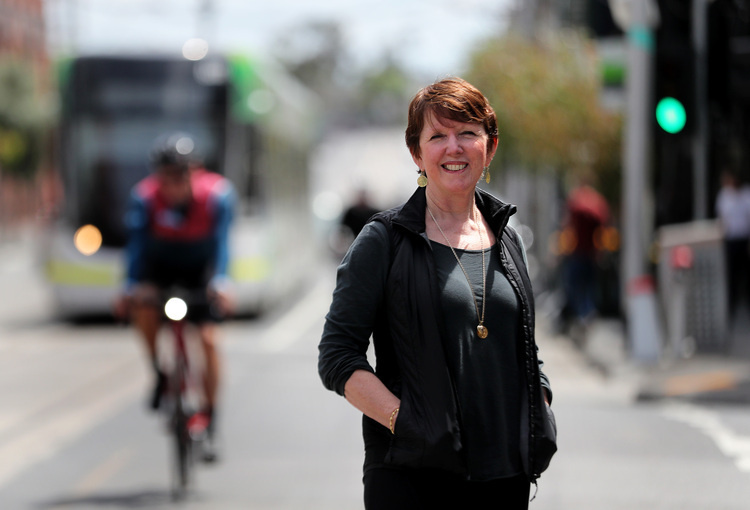MEET BILLIE GILES-CORTI
For over 20 years, Distinguished Professor Billie Giles-Corti has been studying the impact of the built environment on health and wellbeing. With more than 400 publications, Professor Giles-Corti has become a stalwart leader in the field of urban health. Last month, The Lancet Global Health launched a follow-up series on Urban Design, Transport and Health, six years after the first edition published by The Lancet. This series builds on the team’s work Billie presented at ICUH in Coimbra, Portugal in 2017 that culminated in the establishment of the Australian Urban Observatory in 2020.
To accompany this new Lancet Global Health series, the Global Observatory of Healthy and Sustainable Cities was created. The Observatory is an initiative of the Global Healthy and Sustainable City-Indicators Collaboration which, for over 3.5 years, has worked on the papers included in the Series. It is based on a transdisciplinary partnership between different organizations including the People, Health and Place Unit of the Prevention Research Center of the Brown School at Washington University; the International Society of Physical Activity and Health (ISPAH); the International Society of Behavioral Nutrition and Physical Activity (ISBNPA); the International Society of Urban Health (ISUH); and the Executive Committee of the Global Healthy and Sustainable City-Indicators Collaboration.
The mission of the Global Observatory of Healthy and Sustainable Cities is to provide comparable spatial and policy indicators of healthy and sustainable urban design and planning practices to allow tracking progress for achieving cities that, through design - and globally, maximize people’s health and wellbeing, while at the same time contributing to climate change adaptation and mitigation. In line with its mission, the Observatory has been developed scorecards and reports (translated in 16 different languages) for 25 different cities across the 6 continents. These, according to the Observatory, are only the beginning of a greater, bolder, and more global challenge. Indeed, to help achieve its mission, the Global Observatory of Healthy and Sustainable Cities has recently launched the 1000 Cities Challenge and is currently seeking active engagement of data and urban scientists, health and active living researchers, urban practitioners and open science and open street map communities from around the world to join in and get involved in the development of new urban policy and planning indicators in 1000 cities worldwide.
What is the Global Observatory of Healthy and Sustainable Cities 1000 cities challenge and what are you trying to achieve by launching it?
We believe that what gets measured gets done. Our new TLGH series found while most cities have good intentions to create ‘healthy’,‘sustainable’ and/or ‘liveable’ cities, few cities around the world had the policies in place to deliver healthy and sustainable cities; and even in those that did, most cities have spatial inequities in access to health-supportive environments which will widen health inequities. We hope by benchmarking cities we will provide much needed to support better city-planning decision-making. If we use indicators to monitor over time, we can assess whether we are making progress towards creating healthy and sustainable cities and if not, why not?
Who can use the scorecard, reports and indicator tools that have been developed as part of the 1000 cities challenge?
We wanted to enable cities to make change. The scorecards provide a one-page summary of what we found in each of the 25 cities studied. The reports provide these cities with more details about what is working or not.
However, the real value of what we have done is if we can monitor over time; and we involve more cities in creating comparable healthy and sustainable city-indicators. We know that this is not always easy for cities: the skills needed to develop the measures may be lacking and the data may not be readily available.
So the geospatial tool used ‘open street map’ data created by citizens to create the indicators in the Series; and then a series of open indicator tools, that will allow people to replicate what we have done: that might involve one of the 25 cities in the study, monitoring progress over time; or it might involve other cities getting involved to use the tools to benchmark and monitor their city.
The real strength of what we have done is worked with local collaborators to validate what we have done: as more people get involved it is going to be important for them to have local collaborators who can check the data and ensure it is valid. But we hope our tools enable more people to more easily get involved.
How are the healthy and sustainable urban design indicators meant to be used by cities, data scientists, researchers, and/or others?
The indicators can be used by benchmark and monitor progress towards creating healthy and sustainable cities over time; They can be used by city-planners to identify where interventions are needed to create healthy and sustainable cities for all. They can be used by community leaders to advocate for reform and hold city leaders to account.
Moreover, we want more data scientists and urban health and other researchers to get involved to populate the additional indicators needed to deliver the UN SDGs 11 and 3. We have identified 11 urban policies that create 11Ds – 11 urban and transport planning and design interventions – that affect transport mode choices an daily living outcomes that affect health and wellbeing. We want more researchers to get excited and involved and to create evidence-based indicators that can be replicated across the globe and distributed through the Global Observatory of Healthy and Sustainable indicators.
How can others get involved? Is there a way to contribute to the 1000 cities challenge?
We encourage those interested to sign up for the Challenge on the Observatory website. We will run some webinars and training to support people to get involved. We hope to enable collaboration by linking people with expertise in policy, spatial science and health – this is a big agenda, and we want everyone – all members of ISUH and other international societies, to get involved.
Our plan to support translation is to create an automated tool so that once the data is collected, we can create reports for participants to use with their cities to enable change, and support translation of the findings into policy and practice.
Is this a global effort? Are there events that may be happening locally to get involved in?
So far, we have 25 cities actively involved. We have had 8 local launches in those cities with more events planned later in the year. Details of local launches can be found on the Observatory website.
However, we hope that each of the international societies involved in the Observatory – including ISUH – actively encourages its community to get involved: to make this a feature on their Congress programs and perhaps establish a sub-group with energetic leaders that can work in interdisciplinary teams and champion the creation of evidence-based policy and spatial indicators that can be used to benchmark and monitor whether we are making progress towards creating healthy and sustainable cities.
How can I join the 1000 cities challenge?
Please join the Observatory here!


